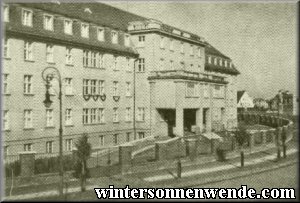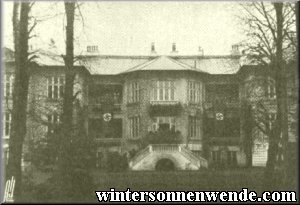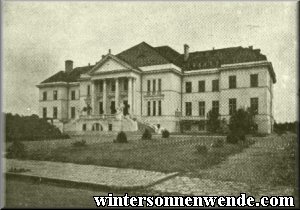 |
 For this chapter in particular,
please note our position on censorship! Health Care Services The conditions which prevailed at the end of the Polish Campaign and which have already been repeatedly touched on in this volume also had extraordinarily unfavorable effects on the health situation. As a result of the destruction caused by the war, approximately half of all housing facilities were initially completely unfit for use. Added to this was the fact that thousands of refugees flooded into the city of Warsaw in October of 1939, adding further multitudes to the population. These two factors combined to produce singularly overcrowded conditions in the residential facilities of Warsaw. It was found that in some cases 30 to 40 people shared one single room. In Krochmalna Street, for example, there were 25 houses and no less than 15,000 inhabitants. The water supply had also been severely compromised by the effects of war. At the waterworks all delivery conduits and fast-filter plants had been completely destroyed. The distribution network itself had been damaged in 700 places. As a result, only 10,000 to 15,000 cu.m. of water were available daily, as compared with the city's peacetime daily consumption of 140,000 cu.m. The people found themselves with no choice but to get much of their water from the Vistula or from dirty wells. This practice led to a minor epidemic of dysentery in the city of Warsaw, with 140 cases, and then to an epidemic of typhoid fever, with 3,785 cases and 405 deaths between October and December of 1939. To bring these epidemics under control, the civilian Department of Health and the Chief Medical Officer of Army Command, Professor Dr. Richter, Captain in the Medical Corps, co-operated closely to bring about an emergency medical organization in which all available Polish and Jewish practising physicians had to take part. Depending on the nature of their professional orientation, these physicians were assigned by the German Health Service to individual city blocks, which it was their responsibility to monitor house by house for ill persons and such as seemed to be infected, as well as for extreme cases of overcrowding. According to the results of the first inspection, 15,000 people were homeless; 30% of the populace had been found to live in basement rooms. That the epidemic of typhoid fever in Warsaw subsided as early as January 1940 is due to this "block physician" system with its daily reports to the German Health Service, as well as to the rapid repair of the water system and to the compulsory inoculation against typhoid fever, ordered by the German Health Service. As a result of the follow-up inoculation of the District's entire population against typhoid, the number of typhoid cases today is so small as to be irrelevant, and is certainly lower than before the times of German Health Care Administration. In 1941–42 the compulsory vaccinations against typhoid also practically eradicated that disease in all counties of the District where it had previously occurred. Dysentery as well, which had been endemic in all parts of the District, has not reappeared since. Combating typhus, on the other hand, was less successful. For the first 1.5 years after the victory over Poland, the number of cases of typhus amongst the Polish populace of Warsaw was in fact kept at less than 10 per month despite the severely overcrowded conditions. But that situation changed when the German armies flooded into the city just prior to the start of the war with Russia. Food became increasingly scarce in Warsaw and especially in the Jewish Residential Quarter. The Jews were therefore most eager to barter for food, and offered the farmers clothing, linen and furs in exchange for groceries. There were countless cases where the county physicians determined a link between new cases of typhus, and furs just previously accepted in trade. Since the boundaries of the Jewish Residential Quarter were by no means perfectly sealed off, it was possible for such bartering to continue via the Polish denizens of Warsaw. This was how typhus spread to the Polish inhabitants of the city as well as the counties in the winter of 1941–42. In spite of all this, it has nevertheless been possible to combat this epidemic effectively as well, so that it has already subsided after only a few months without having had particularly devastating consequences. Even though the situation regarding hygiene and sanitation as well as food supply are far worse during this present war than they were during the first world war, there are far fewer cases of typhus this time. How was this achieved? Having recognized that typhus is spread only by lice-ridden vagabonds, the Health Administration demanded that strict measures be taken against such unsettled social elements, and eventually also achieved the institution of relevant measures. In 1940 lice-ridden Jews had been repeatedly found to be the carrier agents in new cases of typhus, and so strictly delimited Jewish residential sections were set up in the entire District, especially in the city of Warsaw. Though it was extraordinarily difficult to excise the Jews from Polish economic life, their effective isolation was nevertheless achieved in the winter of 1940 thanks to the common sense shown in this matter by all Germans involved. The battle against roving social elements had to be supported by an intensive information campaign to make the people aware of the dangers of typhus. With the co-operation of the Division of Propaganda, a typhus documentary titled "Jews – Lice – Typhus" was filmed which has contributed much to public understanding of the German measures for cordoning off the Jewish areas, and has even resulted in active public support for these measures. A large number of delousing facilities were set up as main thrust against typhus. On October 1, 1939 there were only 9 delousing facilities with a total daily capacity of 1,715 people in all of the District, including the city of Warsaw. By April 1, 1942, 66 permanent local facilities with a sum daily capacity of 9,085 persons had been newly set up. Of these, 14 are located in the city of Warsaw and have a total daily capacity of 2,500 persons. When the number of typhus cases had first begun to increase, the German Administration set up 49 typhus emergency hospitals with 1,825 beds throughout the District. 425 epidemic beds were also readied in the General Hospitals of the city of Warsaw. As part of the state development and expansion of the health care system, the number of government physicians has been increased from approximately 30 to 106 by raising the numbers of city, regional and county physicians in the various county precincts. Today the number of disinfection supervisors stands at 559 (of which 439 are in the city of Warsaw) and there are a total of 68 health inspectors, 32 of them in the city. The small numbers of practising physicians in the various county precincts initially rendered the early recognition of and battle against epidemics in rural areas impossible. By expanding the regional medical system, and by prohibiting the establishment of further medical practices in Warsaw proper, the German Health Administration created an incentive for numerous Polish physicians to set up their practices in rural areas. On April 1, 1942, 591 Polish doctors had practices in the rural counties of the District, whereas in 1940 they had numbered only 290.
The Jews have established 6 more Care Centers of their own in Warsaw. They also had to set up Care Centers in all other major Jewish Residential Quarters, in addition to the delousing facilities. Prior to the war with Poland there had been a total of 41 hospitals in the District, with 10,682 beds. A number of hospitals were damaged in the war, particularly in the city of Warsaw. Nevertheless, 43 General Hospitals with 10,752 beds were already set up and operational by April 1, 1942. Of these, the city itself has 24 hospitals and 9,460 beds, the best of which facilities (including some 3,000 beds) have been made available to the Wehrmacht since the start of the Russian Campaign. The city has been able to obtain 3,000 replacement beds by falling back on the resources of private clinics. Before the war, ambulance and accident emergency service had been the province of numerous private and semi-public enterprises. A public ambulance and rescue service for the District was thus set up, and has since been expanded to include 18 ambulances, 6 of them German Mercedes and DKW vehicles. This organization rendered invaluable service last winter by providing the wounded Wehrmacht soldiers and civilians with speedier transportation from the Eastern Rail Station to the hospitals. The number of x-ray machines for the diagnosis of tuberculosis by the Health Care Centers was tripled in Warsaw as well as in the rural county precincts, and the number of medical examinations has doubled. The Social Security Service has established a large Institute of Physiotherapy, which is available to all Social Insurance members as well as to all Germans. The State Institute of Hygiene in Warsaw was expanded by a typhus research facility which by now produces typhus vaccine in quantities sufficient to meet the needs of the Health Care Administration. And finally, a District Medical Board of Registration was established and now includes 11,500 health care practitioners which are called in by the Health Care Administration when and where they are needed.
As early as May 1940 a severely damaged Polish private clinic was turned into the German District Hospital, which at first included 140 beds and has since been equipped (by the addition of neighboring private villas) to accommodate 3 specialized departments with a total of 300 beds. This hospital is supplemented by the sanatorium of the Wilhelm Richter Foundation in Karolin, a convalescence facility available to all Germans. In June of 1940 the German Pharmacy was established to supply the health care needs of both the ethnic Germans and the Germans from the Reich proper. With the help of this organization it was possible to meet the extensive needs of even the non-German businesses working for the interests of the Reich. The pharmaceuticals industry of Warsaw, which is of great importance to the economy of the General Government, was placed under German management and supervision. Major enterprises which had been destroyed in the war were rebuilt and made serviceable to German interests. The direction of these businesses in the interests of the Reich entailed strict regulations regarding the supply of raw materials to the pharmaceuticals factories and wholesale establishments. The cultivation and collection of medicinal plants was encouraged. Special care was devoted to the ethnic Germans. With the assistance of the Waffen-SS x-ray detail, the Health Administration x-rayed the lungs of some 10,000 ethnic Germans; unfortunately it was found that this ethnic group, which had had to endure Polish conditions for decades, was particularly extensively infected with tuberculosis. For this reason a German Tuberculosis Advice Center was set up which gives continued support and advice to all patients identified in the course of the mass x-ray campaign and which has in many cases sent the patients to the newly established German department of the tuberculosis sanatorium in Rutka. As well, a tuberculosis department has been established in a Warsaw hospital to facilitate the care of those patients who cannot be sent to Rutka. All ethnic German school children were examined, and an ongoing school care organization has been organized for them. Beyond that, the German Relief Organization of the NSDAP has established an Infant Care Center for German babies, with 30 beds. As part of the Public Education Project, lectures about health-related topics were given in Warsaw and those counties inhabited by Germans. It was intended that such education would also contribute to the development of healthier living conditions.
At this time, 5 German midwives stationed at the Aid Centers for Mothers and Children outside of the city of Warsaw ensure that the children of our national comrades living in rural areas no longer need to be delivered by Polish midwives. This is the only way to get the better of the dearth of children which characterizes the ethnic Germans of Poland and which is largely due to an extremely high infant mortality rate.
|











